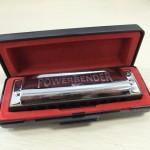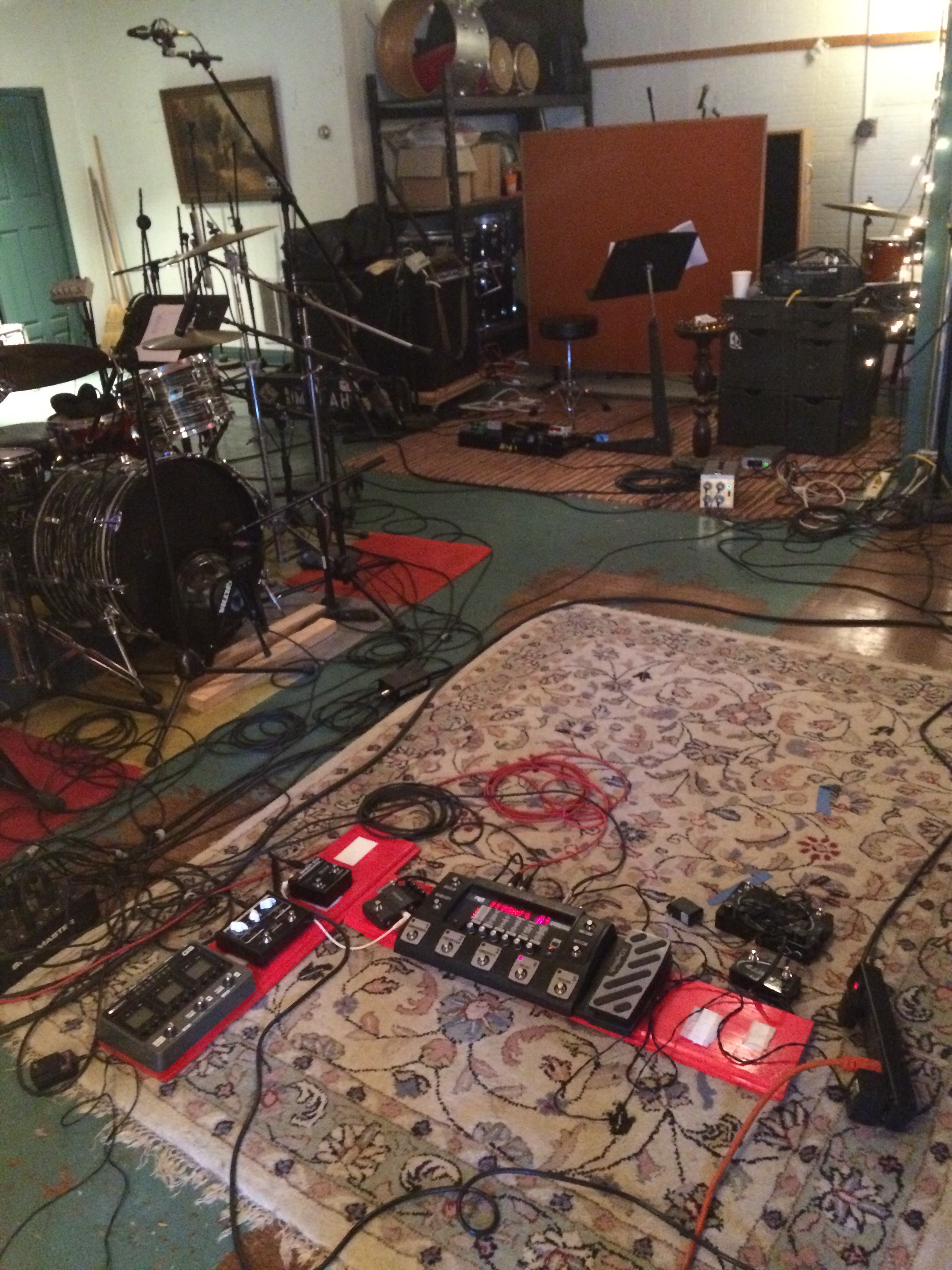
Gear Review: The Powerbender diatonic harp
Brendan Power, by any measure one of the most skillful and innovative harmonica players and composers for the instrument of all time, has recently offered an introductory package for his PowerBender diatonic harmonica tuning. The package includes a Suzuki Harpmaster diatonic harp with PowerBender tuning in the key of A, plus a very thorough and readable booklet that explains the thinking behind the tuning and how to play in every position available in this tuning.
The PowerBender tuning is substantially different from standard Richter, and is designed to make it easier to bend (and so to play expressively) in the upper mid and upper registers. Given that the tuning is the absolutely essential part of this offering–if you don’t like the tuning, the package is pointless–this review will focus first on the utility of the tuning, then on the package that includes it.
The PowerBender Tuning
The PowerBender tuning is set up so that in the upper register the highest note in every hole is a draw note, which means that draw notes can be bent up high just as easily as in the lower register. The middle register is also very different from standard Richter. On a standard Richter, if you inhale on holes 4-7, you get the notes of a dominant 7 chord; on the PowerBender, you get the notes of a major +6 chord (in this case an E+6), and if you exhale, you get the same inversion of the major +6 chord a whole step lower (D+6). This offers some very cool chording possibilities, among other things. It also offers a lot more bending opportunities through the entire range of the harp. (The lowest octave of the instrument is tuned the same as standard Richter.)
In general, the tuning performs as advertised–it makes a lot of expressive stuff that can’t be done on a standard Richter harp easy. No diatonic tuning can possibly do everything for a harp player–the most obvious example is that a given chord voicing can only be played on a harp where the pitches that make up the chord are either all blow or all draw–but this one does a lot of things that blues players in particular will enjoy. It’s very nice to play the upper register more or less the same way you play the bottom octave, with the same expressive moves.
An issue with any new tuning is: how easy is it to learn? I play six different diatonic tunings regularly, and all of them are basically variations on Richter, meaning that the scale tones are found in pretty much the same places on all of them. The learning curve on the Powerbender is probably steeper than going from, say, a standard tuning to a Natural Minor. But I was pleasantly surprised to find that after a couple of hours with the PowerBender I was playing fairly fluently.
In short, the tuning has a lot going for it. One issue that any player must consider is availability: can a player get more instruments with this tuning when needed? One advantage of a standard tuning is that you can get one when you need it at most musical instrument stores. What do you do on a Saturday night when your PowerBender packs up an hour before the show? Of course, if enough people use the PowerBender, that problem will disappear. But in the meantime, players who plan to play the PowerBender frequently had better stock up.
Value for Money
That brings up the issue of pricing and value for money. The package in which the tuning is delivered, as noted, includes a Harpmaster harmonica and a booklet. The booklet is well-written and produced, plentifully illustrated, thoroughly informative, and highly readable. Brendan’s enthusiasm when he encounters unexpected delights in the tuning is infectious. The standard retail price for the package is UK 73 Pounds; I got mine on an end-of-year sale for ten pounds less than that, including shipping from the UK. Current price on Brendan’s site for a Suzuki Harpmaster with Powerbender tuning alone–no booklet–is UK 60 pounds, close to US $100. That is a hefty price for a harmonica that retails in standard tuning for under $30, given that nothing has been done to the harp besides retuning.
By comparison, Lee Oskar non-standard tunings retail for the same price as their standard Richter equivalents. Seydel charges US $109.95 for a non-production tuning on their 1847 model, which retails in standard form for about $70. In other words, Seydel charges about $40 US for a non-production tuning; the price for the tuning alone on the Harpmaster Powerbender (when the cost of the basic harp is subtracted) is closer to $70. The price difference on the higher-end PowerBender harps is even more striking. A Manji in PowerBender tuning goes for about $135, which is almost $85 more than the cost of a standard Manji at coast2coastmusic.com.
I think this pricing is potentially prohibitive for many prospective buyers, especially given the extreme price sensitivity of harp players in general. In response to my inquiry on this subject, Brendan advised that the PowerBenders now available are hand-tuned, a process that is both time consuming (a number of reeds must be weighted with solder before tuning) and expensive. Brendan has made arrangements with an experienced Chinese manufacturer to manufacture PowerBenders in bulk, and the first of these should be available within weeks at a price yet to be disclosed, but undoubtedly much lower than current pricing for Suzuki-based PowerBenders, which Brendan says will “dramatically lower the entry barrier for people who want to test the water with a very playable affordable PowerBender.” A photo of the new instrument provided by Brendan is below.

UPDATE June 29 2011: Brendan’s new harps are now available, and priced well below the previous rate. Brendan is shipping the new Powerbenders for a price of 18 pounds plus 8 pounds international shipping (including tracking). That’s about US $44–not cheap, but a considerable improvement, and we can expect better pricing as other distributors pick the instrument up, reducing shipping and handling costs. The instruments are still only available in the key of A as of this writing. You can order direct from Brendan here.
Summary: It’s Ready if You Are
In the end, this tuning is a powerful tool for harp players. I like mine and intend to get closer to it. As with any new tuning, a player can expect to put a few hours into it before becoming comfortable with it. Those who do will find that this tuning makes some new, exciting sounds.
Related Posts
5 Comments
Leave a Reply
You must be logged in to post a comment.
WHAT’S NEW
Categories
- Audio/Video
- Blog
- Blue Future
- Digitech RP Tricks and Tips
- Discography, CDs, Projects, Info, Notes
- Featured Video
- For the Beginner
- Gallery
- Hunter's Effects
- Hunter's Music
- Huntersounds for Fender Mustang
- Meet the Pros
- More Video
- MPH: Maw/Preston/Hunter
- My Three Big Contributions
- Player's Resources
- Pro Tips & Techniques
- Recommended Artists & Recordings
- Recommended Gear
- Recorded Performances
- Reviews, Interviews, Testimonials
- The Lucky One
- Uncategorized
- Upcoming Performances
- Zoom G3 Tips and Tricks


Great review, Richard… makes me want to check it out. One minor quibble that I need to raise, as a Seydel endorser. The 1847 actually retails for $89.95 in standard tuning, and $109.95 for a configurable tuning. So the markup is only $20 for an alternate tuning (actually less for Paddy Richter, which is $95.95).
Noted and thanks, RH
Hi Richard, have I read this correctly: “draw notes can be bent up high just as easily as in the lower register” Bent up? Oh, I just got it as I’m typing! Up high on the harp, draw bends are available, as they are in the lower range. (whew) thanks again for your research and sharing. –Robert in Gilbert AZ (Phoenix)
You figured it out. Thanks, RH
I recently received a Brendan Power POWERBENDER and it is a delight! The reeds are very responsive so when I use it in a harmonica holder while playing guitar it is does not require the effort it takes from other harmonicas, so it is a smoother experience. All the notes bend easy even in the upper register. I have manji, hohner and Oskar harmonicas and to me this harmonica is more responsive and expressive than any of them. It does take time to figure out old melodies due to the new tuning, but not to bad. The new jazzy sound is worth the learning curve.